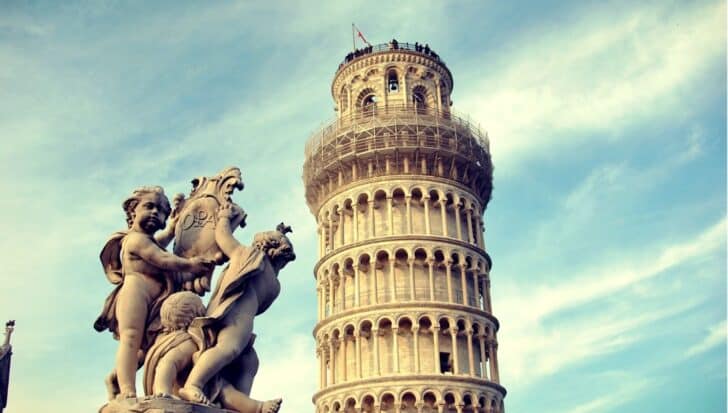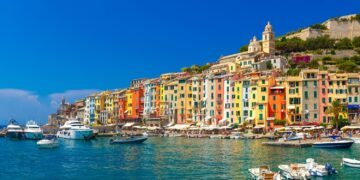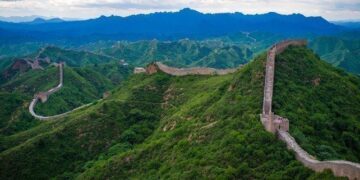We’ve all seen the photos of tourists posing with the Leaning Tower of Pisa, pretending to hold it up.
This famously tilted tower provides the perfect backdrop for an interesting snap and attracts millions of visitors every year.
But beyond the amusing pictures, the Leaning Tower of Pisa has a fascinating story.
Let’s explore some of the puzzling facts about this iconic tower!
The Leaning Tower of Pisa is one of the Wonders of the World.

This remarkable construction features on many ‘Seven Wonders of the World’ lists, alongside landmarks like the Great Wall of China and Italy’s other monumental marvel, the Colosseum.
It is widely considered one of the most interesting structures of the Middle Ages.
The Leaning Tower of Pisa has become internationally renowned for its beautiful architecture and unique tilt.
It stands alongside Pisa Cathedral, Pisa Baptistery, and the Camposanto Monumentale (the Monumental Cemetery) in Piazza dei Miracoli (the Square of Miracles).
The tower was never meant to lean!
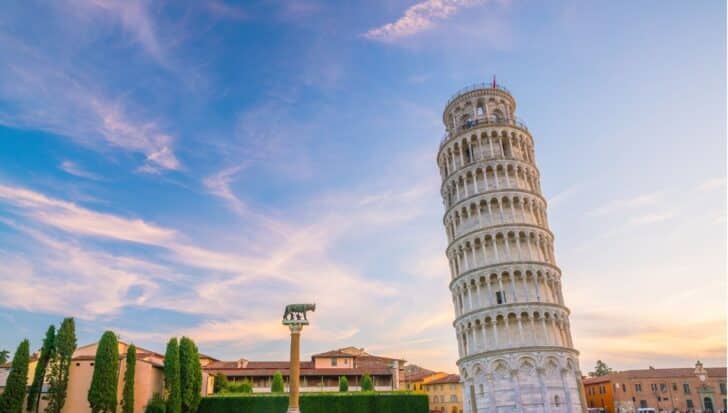
The Leaning Tower of Pisa was built on soft ground that could not support its weight.
The unstable foundations, made of clay, sand, and shells, caused the tower to settle unevenly during construction.
This unevenness caused the tower to tilt slightly, creating the famous leaning structure we are familiar with today.
This happy accident is one of the main reasons millions of people flock to Pisa to see the Leaning Tower!
It took hundreds of years to build the Leaning Tower of Pisa.
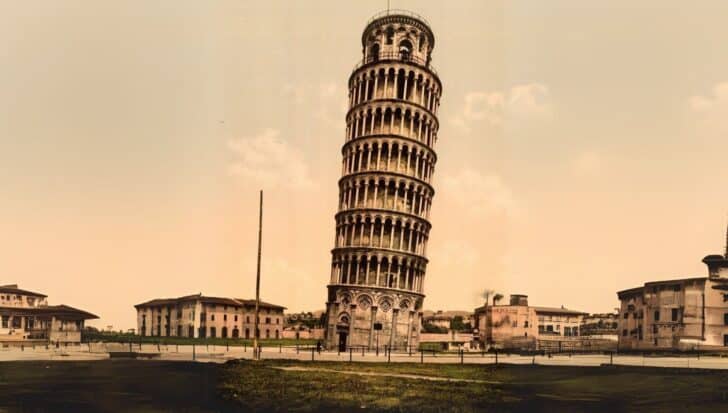
Construction of the tower began in August 1174, but it wasn’t until 1372 that the building opened to the public.
The process took almost 200 years and was disrupted by conflicts, financial troubles, and structural problems.
Three of the eight stories had been built when the structural flaws (the lean) started to show.
Engineers spent a lot of time trying to find solutions to straighten the tower, which took precious time away from the building process.
Wars between Italian cities further delayed the project by almost 100 years.
Funnily enough, these delays are to thank for the tower’s survival; the additional time helped the foundations finally settle, which prevented the tower from collapsing!
The Leaning Tower of Pisa has survived disasters because of its structural flaws.
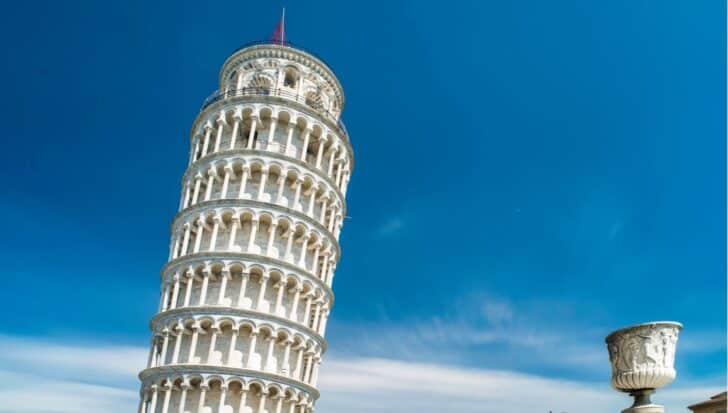
Since 1200 A.D., the Leaning Tower of Pisa has weathered the impact of four harsh earthquakes.
Italy is prone to these natural disasters, and earthquakes such as the one in 1908 caused immense destruction to homes and buildings in the surrounding area.
By all rights, at least from an uneducated perspective, the tower should have fallen down. Yet it stands tall against the odds!
Scientists have since concluded that the tower can withstand the impacts of a strong earthquake because of its soft foundations and stiff structure, which counters the intense tremors.
Who would have thought the flaws of the Leaning Tower of Pisa could be the same reason it has survived so long?
Its largest bell weighs as much as an elephant!
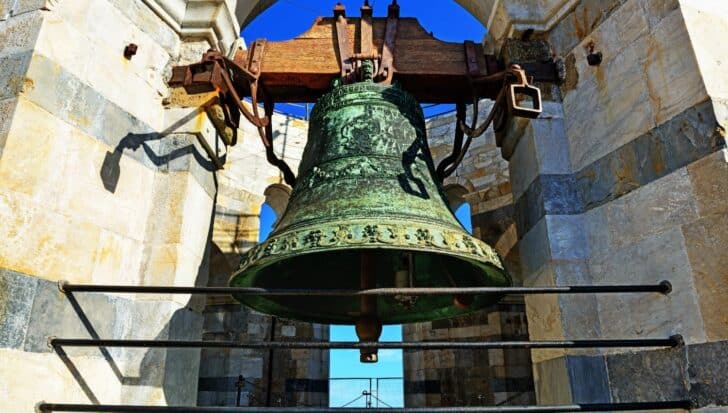
The Leaning Tower of Pisa was created as a bell tower and is home to seven large bells, which represent the seven different musical notes.
The largest bell weighs around 7,900 lbs (3,600 kg), about the same as a female African bush elephant!
Visitors must climb a whopping 273 steps to the top of the tower, some 190 feet (58 meters) high, to see the bells close up.
While the bells were traditionally heard ringing through the square, the heavier bells were silenced in the early 1900s.
People thought the constant movement from the bellringing might make the tower lean even further.
Work was carried out in the 1990s to prevent the tower from collapsing.
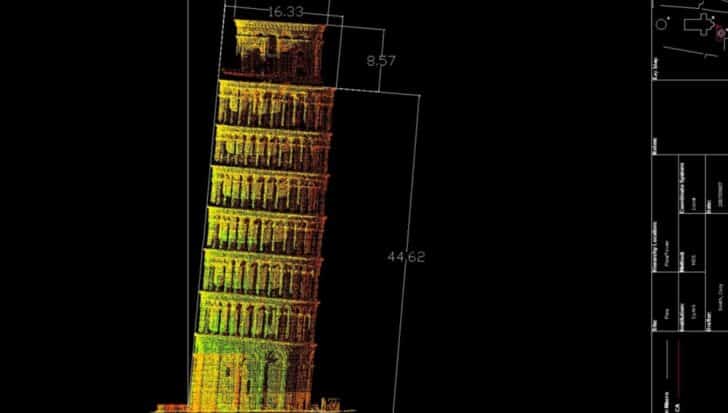
As time passed, the tower sank further into the foundations, making it lean even more.
It wasn’t until 1911 that the rate at which it sank was actually measured, though, and the results were alarming.
The Leaning Tower of Pisa was also a sinking tower, sinking up to 0.05 inches (1.2 mm) annually!
By 1990, many people thought the tower would collapse as it reached a record tilt of 5.5 degrees.
A team of engineers was tasked with straightening the tower and reinforcing the foundations.
The works ended up running from 1993 to 2001, with the engineering team reducing the tilt to 3.97 degrees.
Experts believe these structural works will keep the Leaning Tower of Pisa standing for at least 200 more years.
Galileo Galilei’s Leaning Tower of Pisa experiment may never have happened.

If you drop items with different masses from the top of a tower, they will reach the ground at the same time.
This was the discovery supposedly made by Italian physicist Galileo Galilei in his Leaning Tower of Pisa experiment during the 16th century.
In a biography by Galilei’s personal assistant, Vincenzo Viviani, he writes that the experiment was conducted in front of professors, students, and scholars.
Many historians have disputed the accuracy of this story, however, as it was never mentioned in any of Galilei’s research.
Nobody seems quite sure whether it really happened and what the outcome was. One letter from Galileo to a mathematics professor even suggests the objects hit the ground at different times!
Soldiers during World War II saved it from destruction.

Sergeant Leon Weckstein, a 23-year-old American soldier, couldn’t bring himself to order the destruction of the Leaning Tower of Pisa in July 1944.
In a book published in 2001, Weckstein recalls being tasked with finding out whether German soldiers were in the Leaning Tower of Pisa.
To that day, he could not be sure whether the enemy soldiers were inside or not.
But when faced with the choice of whether to take the risk and blow up the tower, Weckstein decided to spare it.
The tower, alongside the cathedral and baptistery, was too beautiful and ornate to ruin.
It is part of a world-renowned heritage site.
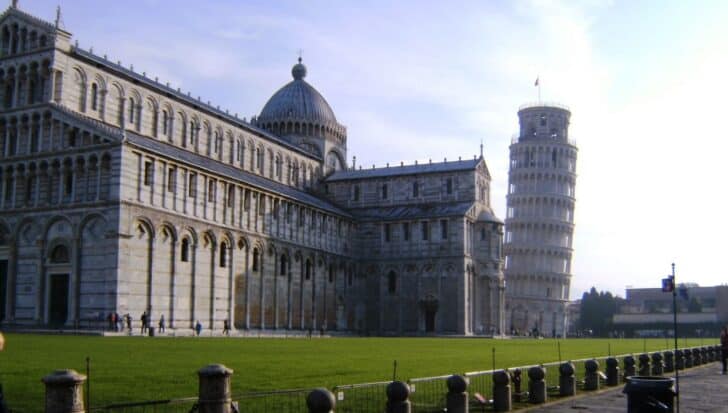
Piazza dei Miracoli, previously known as Piazza del Duomo, was recognized as a UNESCO World Heritage Site in 1987.
The Leaning Tower of Pisa shares this accolade as a central part of Pisa’s famous square.
Sites must meet specific criteria and have ‘outstanding universal value’ to qualify for this internationally renowned label.
The Leaning Tower and its fellow monuments are recognized for their influence on art, architecture, and science.
Italian leaders have tried to change the tower.

When Benito Mussolini became Prime Minister of Italy in 1922, he did not like the Leaning Tower of Pisa.
He thought it was an embarrassment and an inappropriate structure for the fascist state he wanted Italy to become.
Mussolini hired a team of engineers to straighten the tower. They drilled holes into the foundations and poured hundreds of tonnes of concrete into them.
But instead of fixing the problem, it made the Leaning Tower of Pisa tilt even further!
Now you know the unsteady foundations are why the Leaning Tower of Pisa got its name.
It took decades to build, but its beauty has become globally renowned.
While not everybody likes the tower, it has appeared on many top lists, and the United Nations has recognized it as a special heritage site.
Whether planning a trip to Pisa or wanting to impress your friends at the next quiz, you’re clued up with plenty of facts about the Leaning Tower of Pisa!

